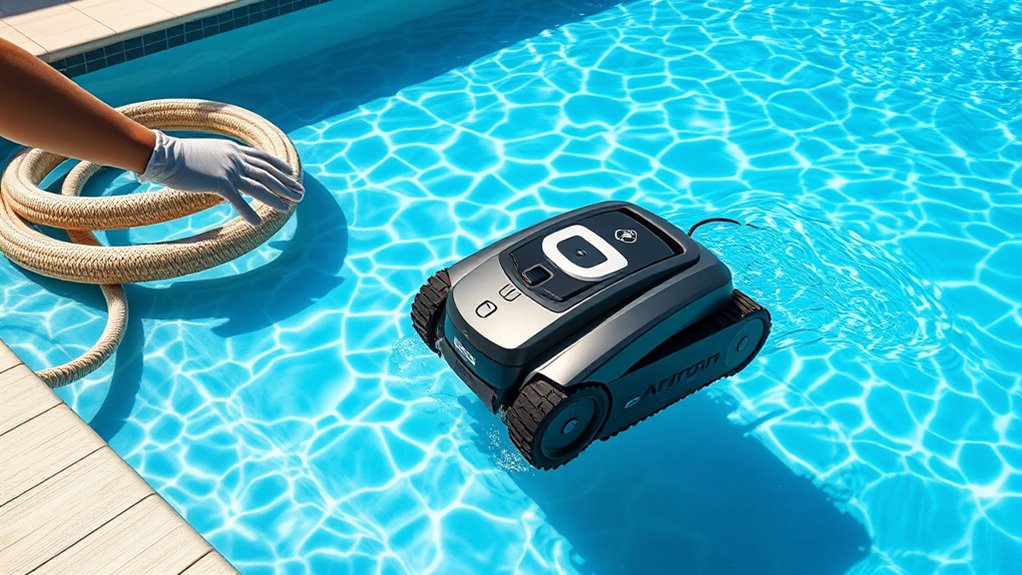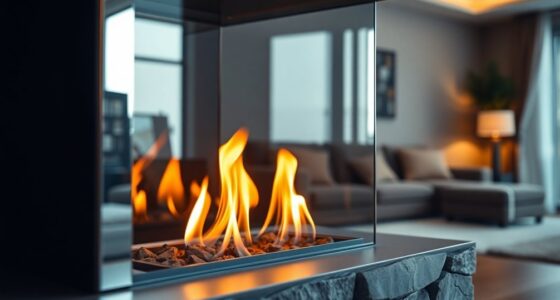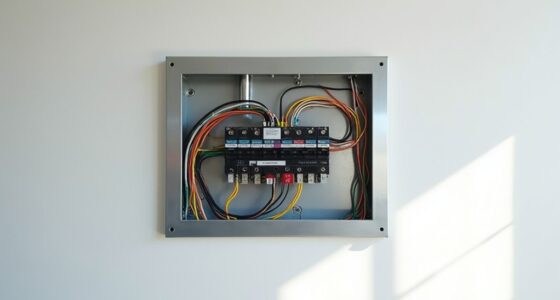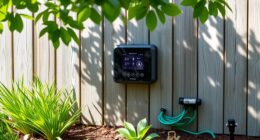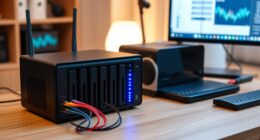When using your automatic pool cleaner, make certain you install it properly and keep cords clear of tangles or damage. Regularly inspect and maintain filters, brushes, and electrical connections to prevent malfunctions. Always unplug and turn off the device before cleaning or repairs, and keep children and pets away during operation. Using a GFCI outlet adds safety, and monitoring the cleaner helps catch issues early. For detailed safety tips, there’s more to cover if you continue exploring.
Key Takeaways
- Always read and follow the manufacturer’s instructions before operating the pool cleaner.
- Keep children and pets away during cleaning to prevent accidents.
- Use a GFCI outlet and avoid wet conditions to ensure electrical safety.
- Regularly inspect and maintain the cleaner, including cleaning filters and checking cords for damage.
- Turn off and unplug the device before cleaning, repairs, or removing debris.
Proper Installation and Placement
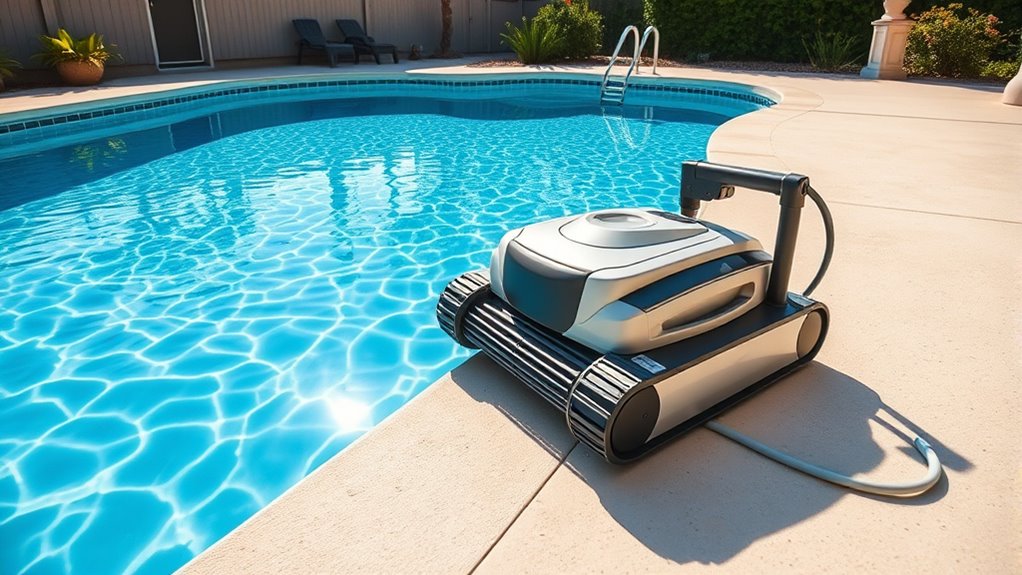
To guarantee your automatic pool cleaner works effectively and safely, proper installation and placement are essential. Start by placing the cleaner in a stable position where it can easily access the entire pool. Make sure the robot’s navigation system is unobstructed, allowing it to move freely without interference. Proper placement helps optimize robot navigation, which is vital for thorough cleaning. Make sure the debris detection sensors are clean and functioning correctly, so the cleaner can identify and remove debris efficiently. Avoid placing the unit near obstacles or in tight corners where it might get stuck. Regularly check that the cords are not tangled and that the cleaner is seated properly. Ensuring your pool’s filter system is clean and functioning well can significantly improve cleaning performance and safety during operation. Additionally, maintaining the battery life of your cleaner can prevent unexpected shutdowns during use. Proper installation and mindful placement are crucial for robot navigation efficiency, which is essential for comprehensive cleaning. Regularly inspecting the sensor calibration helps maintain optimal debris detection and overall performance. Furthermore, understanding the importance of lifecycle maintenance can extend the lifespan of your pool cleaner and ensure consistent performance.
Regular Inspection and Maintenance
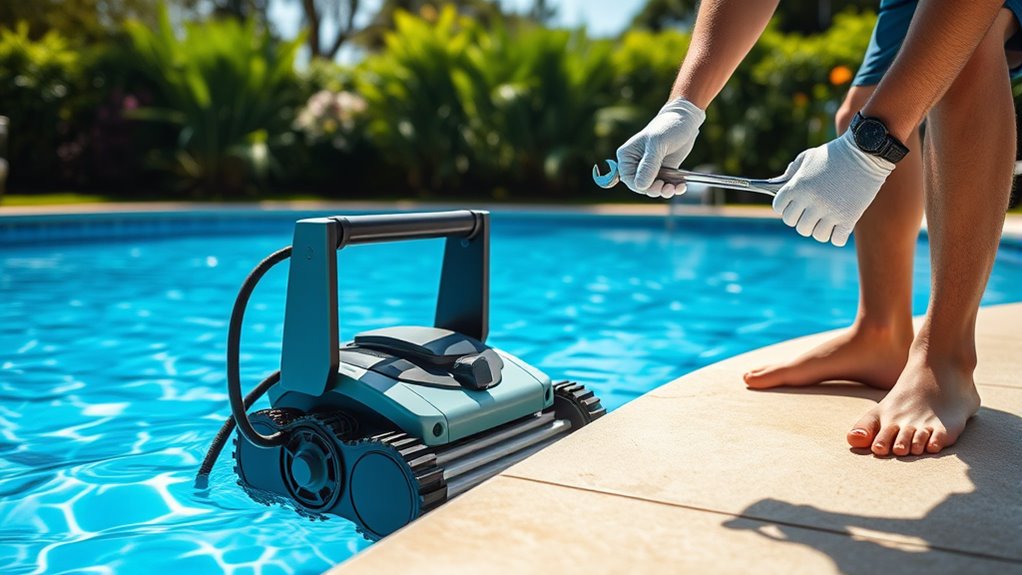
Regular inspection and maintenance are key to keeping your automatic pool cleaner operating at peak performance. Regularly check for debris buildup and remove it promptly to prevent clogs. Also, prioritize filter replacement to guarantee maximum suction and cleaning efficiency. To keep your cleaner in top shape, follow these steps:
Regular maintenance ensures your automatic pool cleaner runs smoothly and lasts longer.
- Inspect the debris basket and clear out any debris.
- Check the filter for dirt or damage and replace it if necessary.
- Clean the cleaner’s brushes and wheels to prevent obstructions.
- Test the cleaner’s movement and suction to catch any issues early.
- Regular monitoring of the cleaner’s behavior helps identify potential vulnerabilities before they lead to malfunctions. Incorporating heat pump maintenance practices, such as inspecting for refrigerant leaks, can also enhance overall system longevity. Additionally, routinely inspecting the automatic pool cleaner’s components ensures all parts are functioning correctly, reducing the risk of unexpected breakdowns. Checking the electrical connections for proper insulation and securing loose wires can prevent electrical failures. Performing these tasks weekly helps prevent malfunctions and extends the life of your cleaner, ensuring safe and effective operation every time you hit the pool.
Safe Handling and Storage Practices
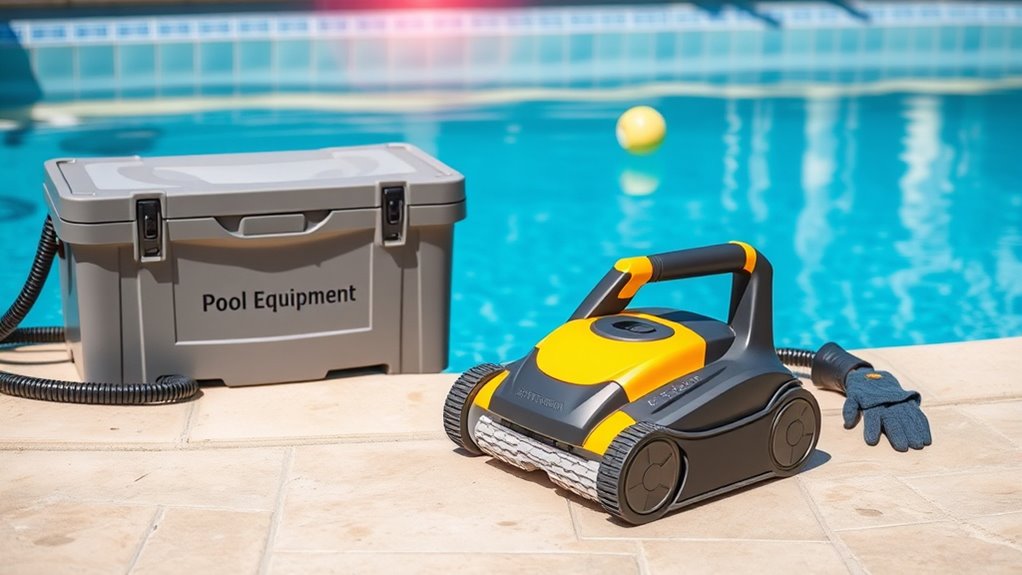
Handling and storing your automatic pool cleaner safely is essential to prevent accidents and prolong its lifespan. Always rinse the cleaner thoroughly after use to remove any chemicals, reducing chemical exposure risks. Store it in a cool, dry place away from pool chemicals and pests. Keep the power cord untangled and secure to avoid damage. Proper storage prevents pest infestation and accidental injury. Use this table for quick tips:
| Safe Handling | Storage Tips |
|---|---|
| Rinse after each use | Keep in a dry, shaded area |
| Avoid chemical contact | Store away from chemicals |
| Disconnect power before handling | Elevate to prevent pests |
| Regularly inspect for damage | Ensure secure, pest-proof storage |
Additionally, proper maintenance can help extend the life of your cleaner and ensure safe operation. Regularly inspecting your cleaner for damage and wear can prevent malfunctions and safety hazards. For optimal performance, it’s also important to follow manufacturer guidelines and clean your filter regularly. Implementing routine maintenance ensures your cleaner remains in top condition and safe to use. Being aware of industry trends can help you keep your equipment up-to-date and functioning safely. Following these practices keeps your cleaner safe to use and in top condition.
Monitoring During Operation
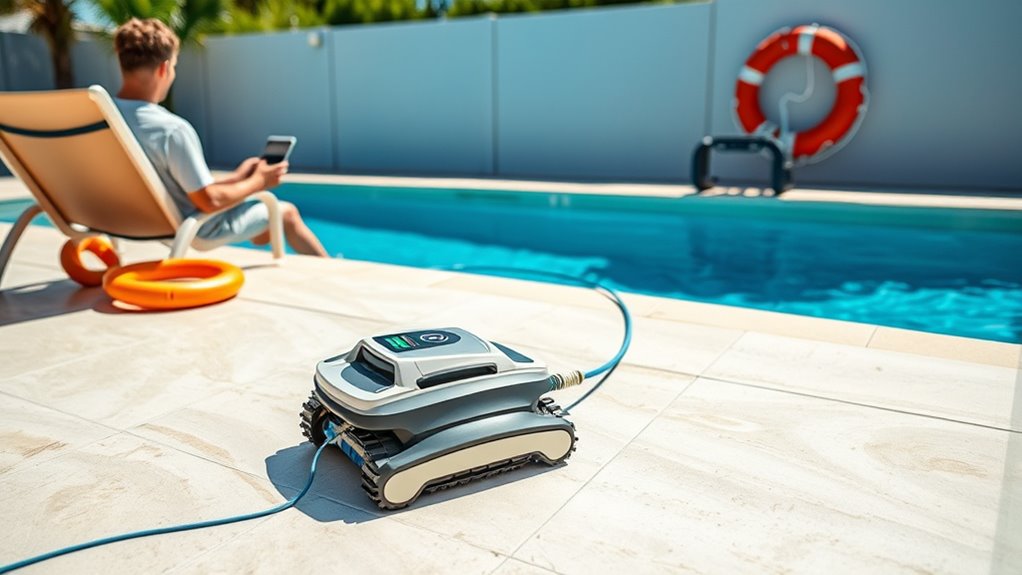
Monitoring your automatic pool cleaner during operation helps guarantee it functions effectively and prevents potential issues. To do this, follow these steps: 1. Check the sensor calibration regularly to ensure sensors accurately detect debris and obstacles. 2. Keep an eye on the cleaner’s movements to identify irregular patterns or stalls. 3. Observe how the cleaner navigates the pool, adjusting user training as needed to improve efficiency. 4. Watch for warning signals or error messages from the device’s control system. Regular maintenance routines also extend the lifespan of your pool cleaner and improve its overall performance. Being aware of common malfunctions can help you troubleshoot problems quickly and prevent costly repairs. Additionally, familiarizing yourself with waterpark safety practices can contribute to a safer environment during pool maintenance and use. Incorporating monitoring techniques can further enhance your ability to detect issues early and ensure consistent cleaning efficiency. Staying informed about environmental considerations can help you maintain your pool responsibly and sustainably.
Precautions for Electrical Safety
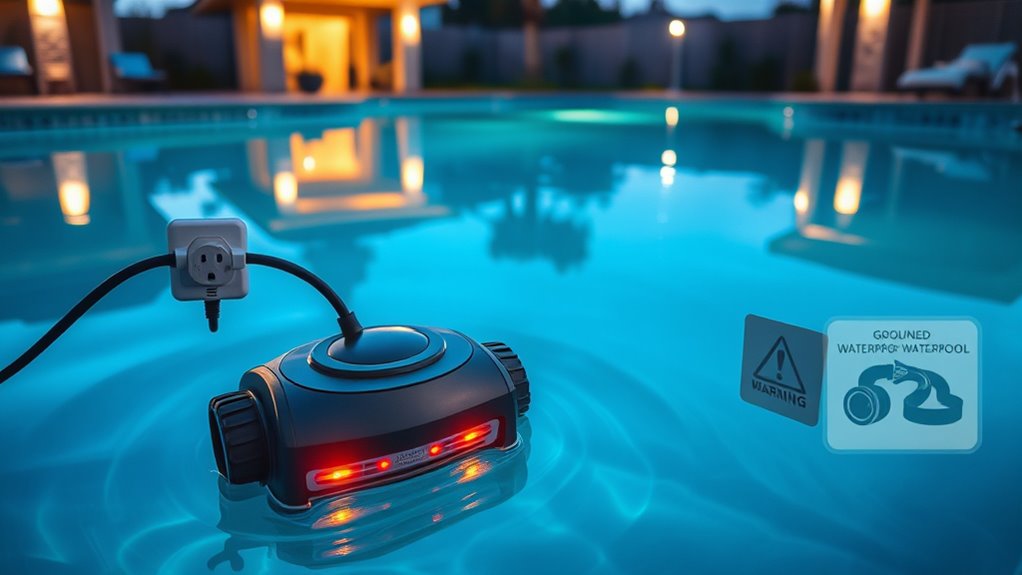
To prevent electrical hazards, always guarantee your automatic pool cleaner is unplugged before inspecting or performing maintenance. Avoid contact with water while plugging or unplugging the device. Use waterproof connectors designed for pool environments to prevent moisture from causing shorts or shocks. Installing a ground fault circuit interrupter (GFCI) is essential, as it quickly cuts power if a ground fault occurs, protecting you from electric shock. Regularly inspect cords and connectors for damage, and replace any worn or compromised parts immediately. Never bypass safety features or connect the cleaner to non-rated outlets. Keep all electrical components dry and away from the water’s surface. Additionally, understanding proper electrical safety procedures and the importance of adhering to safety standards can help you minimize risks and ensure safe operation of your automatic pool cleaner. Familiarizing yourself with electrical codes relevant to pool equipment is also key to preventing accidents. Following these precautions minimizes the risk of electrical shock and ensures safe operation of your automatic pool cleaner. Implementing electrical safety tips can further reduce potential hazards and promote safe use.
Frequently Asked Questions
Can Automatic Pool Cleaners Be Used in Saltwater Pools Safely?
Yes, you can use automatic pool cleaners in saltwater pools safely, but you need to take into account corrosion risks and salt compatibility. Make sure your cleaner is specifically designed for saltwater environments, as some models may be prone to corrosion. Check the manufacturer’s instructions for salt compatibility, and clean and maintain your cleaner regularly to prevent damage. Doing so helps extend your cleaner’s lifespan and keeps your pool clean and safe.
How Long Should I Run My Automatic Pool Cleaner Each Session?
You should run your automatic pool cleaner for about 2 to 4 hours per session, depending on your pool’s size and debris level. This fits well within your maintenance schedule and helps keep energy consumption reasonable. Regular cleaning prevents buildup and guarantees peak performance. Keep an eye on your cleaner’s cycle time, and adjust as needed to balance thorough cleaning with energy efficiency and your pool’s specific needs.
Are There Specific Safety Gear Recommendations When Handling Cleaners?
When handling automatic pool cleaners, you should wear protective gloves to prevent skin irritation from chemicals or debris. Eye protection is also recommended to guard against splashes or accidental contact with cleaning solutions. Always wash your hands afterward and inspect the equipment for any damage before use. Following these safety measures helps keep you safe while maintaining your pool cleaner effectively and reduces the risk of injury.
What Should I Do if My Cleaner Gets Stuck Underwater?
If your pool cleaner gets stuck underwater, you should immediately turn off the power to prevent underwater entrapment. Carefully retrieve the cleaner using a pole or net, avoiding direct contact. Regular pool cleaner troubleshooting can help identify issues early. To prevent underwater entrapment, make certain hoses and cords are free of tangles and follow manufacturer instructions. Always supervise the pool while the cleaner operates for added safety.
Are There Age Restrictions for Operating Automatic Pool Cleaners?
Think of your pool like a treasured garden—only trusted hands should tend it. Yes, there are age restrictions for operating automatic pool cleaners. You should always guarantee child supervision and check for safety certifications before allowing anyone, especially kids, to handle them. Age limits vary by model, but generally, children under 14 shouldn’t operate these devices alone. Prioritize safety to keep your pool environment fun and accident-free.
Conclusion
By following these safety tips, you’ll keep your pool cleaner running smoothly and safely. Always stay vigilant and perform regular checks to prevent accidents. Remember, safety isn’t just a one-time effort — it’s a continuous process. As the saying goes, “A stitch in time saves nine.” Staying proactive guarantees you enjoy your pool without worries, making every swim safe and fun for everyone.
